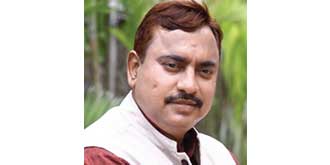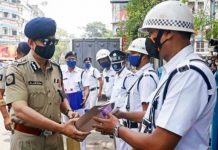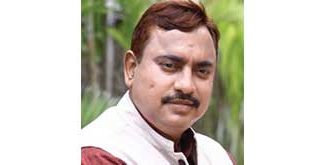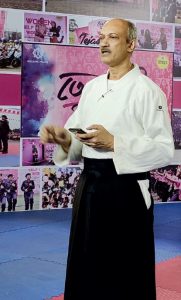 Exclusive: Interview: Avijit Mitra, Black belt, 4th Dan, Aikido
Exclusive: Interview: Avijit Mitra, Black belt, 4th Dan, Aikido
The COVID-19 pandemic has wrecked havoc across the world and Kolkata is no exception. With restrictions in place, normal life in the city has come to a standstill.
Under the lockdown, people have to rethink a new normal to restart their lives. Tejashwini, the self-defence workshop for women, organised by the Kolkata Police, which had become quite popular in its previous editions as hundreds of young enthusiasts undertook martial art training, was held in a different format.
With social distancing norms in place due to the outbreak of COVID-19, it was not possible to arrange such workshops like in the past. So, Kolkata Police decided to organize the workshop in virtual mode. In spite of being held on a virtual platform, it attracted huge attention from all over the country. Avijit Mitra, Black belt, 4th Dan, Aikido, a renowned international figure in martial arts, took the onus to train the participants in online mode. The discipline is based on principles of balance of energies and respect to the partner. It is aimed for men and women, with no age limit or special preparation.
The practitioner studies the basic principles of martial arts: movements, dodging, grappling techniques, distance and gradually overcomes the opponent with bare hand techniques, projections and also with the help of weapons within the framework of the dojo. Unlike other martial arts, physical strength, size, and age have a relatively small impact on one’s ability to effectively practice Aikido. This skill puts our body in harmony with mental and physical strength. Mohammad Asif, Assistant editor of Protector, talks with Avijit Mitra about the new edition of Tejashwini in its new format.
Q. The pandemic has forced the Tejaswini organisers to hold the workshop in online mode. How was it different from past editions?
A. It was a completely different phenomenon because such programmes largely depend on face-to-face interaction and live demonstration. But martial arts basically involves physical and mental training. As physical presence was not possible, so we relied on the mental aspect. We asked the participants of the programme to keep someone as a partner during the training session, so that all moves may be practiced instantly. Since, mere viewing on the screen may not teach them all the moves, we demonstrated every move repeatedly and asked everyone to practice similarly. Therefore, definitely this situation required some special improvisation.
Q. What kind of difficulties did you face while conducting such training sessions?
A. Here, the key problem was monitoring the performance of the participants. In a regular session, we usually monitor every participant. At least 10 assistant instructors help me in such programmes. But, here the situation was not conducive to monitor 300 odd participants. So, what we did was, we repeated every move so that they can be learned properly. The kolkata police might even consider arranging some special sessions where everybody can be present physically. But that is possible only after the present situation becomes normal.
Q. Since here stress is on Aikido, can you please elaborate the relationship between self- defence and spiritual harmony?
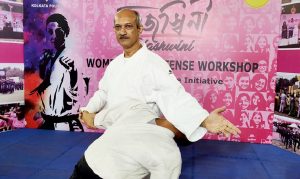 A. Spiritual harmony is not just related to self -defence, but it connects life with your body and mind. Until and unless you recognise the spiritual energy within, it’s difficult to acquire the spirit of harmony. This spiritual energy actually strikes a perfect balance between your body and mind. It keeps you active and alert your keeps you conscious about your surroundings. This energy helps you to take right decisions in crucial moments. Mere learning of martial art moves will not help you until you understand its proper application. When someone is in trouble, this energy actually helps you to master the courage to overcome the situation. It keeps you fearless to think and choose the right move at the right time. Self-defence technique is not to harm others but it’s a sense of completeness which is to be inculcated for self-protection. The most important part of spiritual harmony is world peace. This comes from within. In most cases people attack out of fear. But, those who are aware of their strength, never attack others. The key word of all traditional martial art is world peace. We spread this message of world peace through this art. Samurai warriors always carried weapons with them. But, those who never had to use them considered it a matter of pride.
A. Spiritual harmony is not just related to self -defence, but it connects life with your body and mind. Until and unless you recognise the spiritual energy within, it’s difficult to acquire the spirit of harmony. This spiritual energy actually strikes a perfect balance between your body and mind. It keeps you active and alert your keeps you conscious about your surroundings. This energy helps you to take right decisions in crucial moments. Mere learning of martial art moves will not help you until you understand its proper application. When someone is in trouble, this energy actually helps you to master the courage to overcome the situation. It keeps you fearless to think and choose the right move at the right time. Self-defence technique is not to harm others but it’s a sense of completeness which is to be inculcated for self-protection. The most important part of spiritual harmony is world peace. This comes from within. In most cases people attack out of fear. But, those who are aware of their strength, never attack others. The key word of all traditional martial art is world peace. We spread this message of world peace through this art. Samurai warriors always carried weapons with them. But, those who never had to use them considered it a matter of pride.
Q. In the previous editions of Tejashwini, martial art was part of self-defence on streets. This time you are talking about a sense which is more inclusive. How do you see the difference?
A. It is not wise to keep the sense of self-defence confined within the idea of street fighting. Street fighting is a small part of martial art training. We train people to boost their physical and mental strength so that they are prepared to face all kinds of challenges. It is more important to bring a sense of self confidence within. Somehow, it connects with our traditional Yoga. Learning a few moves and techniques may give one some advantage, but it is more important to decide when and how to apply them. This perception is more important. We stress on that. It empowers one in making the right decisions in situations of threat and helps one in using one,s presence of mind. You can fight one or two people, but if you are under attack from several people, will it be wise to fight them or to escape from them safety ?Comprehending such situations quickly and acting instinctively to the best of your ability is most important. Our training enables you to make such decisions with improved physical and mental strength.
Q. What is Aikido? Could you elaborate, please?
A. Aikido is a traditional and non-violent form of Japanese Martial Art. It is actually derived from aikitaijustu. Aikido is a more refined form of martial art. Here Ai-ki-do is a combination of three words. Where the word Ai stands for harmony, ki means spirit or energy, do means way. If combined together it means the way of spiritual harmony.
Q. How is Aikido different with other martial arts?
A. Aikido is basically a combination of three different practices. This is a pure form of Japanese Martial Art. Other forms of martial art have become part of sports. But, this one remains as a pure form of martial arts. It has not become sports because techniques applied here may sometimes cause severe injury. In Aikido there are three separate disciplines. They are Aikitai, Aikijo and Aikiken. Among these, Aikijo teaches about basic ground movement strategy of combat, Aikiken teaches about spiritual energy and Aikitai bridges the two. Aikijo is practiced with a wooden stick, Aikitai with bare hands and Aikiken with wooden swords. All three are a complete set of aikido techniques that complement each other.
Q. Tell us something about your journey to the world of sports?
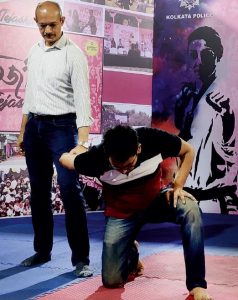 A. At a young age, I was attracted towards martial art by Bruce Lee films. His films inspired many towards martial art. In 1980 at Vivekananda Road YMCA, there was a training centre for karate. The trainer was known to my father. I was admitted there. In 1990, while teaching Karate in Calcutta Judo Club, I saw a french lady practicing Aikido . Their movements were very graceful. I was attracted to this new technique. I felt that I needed to learn this new form of martial art. Later, the lady, Sylvie Wiedeman, agreed to train me. Finally, we managed to start an Aikido class at Calcutta judo club. My students also joined that class. Later, I went to France twice in 1992 and 1993 for a month- long teacher’s training. After undergoing rigorous training, I was given the responsibility to set up an Aikido academy. It was the first of its kind in India.
A. At a young age, I was attracted towards martial art by Bruce Lee films. His films inspired many towards martial art. In 1980 at Vivekananda Road YMCA, there was a training centre for karate. The trainer was known to my father. I was admitted there. In 1990, while teaching Karate in Calcutta Judo Club, I saw a french lady practicing Aikido . Their movements were very graceful. I was attracted to this new technique. I felt that I needed to learn this new form of martial art. Later, the lady, Sylvie Wiedeman, agreed to train me. Finally, we managed to start an Aikido class at Calcutta judo club. My students also joined that class. Later, I went to France twice in 1992 and 1993 for a month- long teacher’s training. After undergoing rigorous training, I was given the responsibility to set up an Aikido academy. It was the first of its kind in India.
Q. Tell us something about your sports life?
A. I was inclined towards sports since my childhood. From a young age, I had interest in shooting but couldn’t continue it for long as it was expensive. Buying pistols at that time was quite difficult. Later, I went to SAI for training in athletics. I took training in discus throwing. But, I didn’t go for any competition. Gradually, I shifted my attention completely to martial arts.
Q. Tell us something about yourself and the present state of Aikido in West Bengal.
A. I have never pursued after fame. But whatever I did was for the love of martial art. Those who want to pursue it seriously, join us. But, it is not popular like other sports, as there is no competition. I have never vouched for publicity. I was invited to to train participants in a self defence programme organised by American library. This time with the help of the Kolkata Police, the workshop was well organized on the virtual platform. So it was a different experience for me.
Q. What kind of response you are getting?
A. Almost 1,354 aspirants had applied for the session. But, only 300 were chosen by the Kolkata Police for this edition due to the limitations of the virtual medium. The training continued for five days. Just from the number of aspirants you can have an idea of the response. With every edition of Tejashwini, I guess the number is increasing. Most of the participants who took part in it were eager and motivated. Many of them are keen to attend such sessions face to face. In this pandemic situation, the initiative taken by the Kolkata Police was innovative and encouraging. Once this pandemic gets over, such training sessions with physical presence may be more effective.

